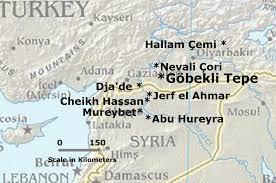One of things I enjoy doing is engaging in informed speculation regarding the beginnings of modern mankind. To that end, I have studied the ‘Old Testament’ of the Bible, assuming it is a muddled record of oral traditions handed down by the Paleolithic peoples that settled in the Fertile Crescent of Lebanon, Syria, Israel and Iraq around 20,000 B.C.
Of particular interest is the location of the ‘Garden of Eden’. To me, this represents a specific paradise of plants and animals for the Hunter-Gatherer culture there. I think I have narrowed the location down to just below the steppes of the Tarus Mountains in northwest Syria. At a place the archaeologists call Abu Hureyra, a village existed in 12,300 B.C. and it was occupied on a steady basis until about 10,800 B.C.
The thing about this village is that it was occupied year-round before the invention of agriculture. This sedentary life style was supported by virtue of the enormous quantity of edible plants, birds, and animals in the vicinity of a prehistoric lake and the river that fed it. The lake and the river do not exist today. These folks, whom archeologists call the Natufian culture, enjoyed the most attractive environmental conditions that had existed for many thousands of years in the Levant, since long before the last glacial maximum.
The scientists found no evidence of warfare, trauma, nutritional deficiencies, or infectious diseases. Their distant neighbors in the region, on the other hand, had to struggle in more arid conditions, with spotty takes of game and wild plant foods. Then, around 10,800 B.C. the environment changed with the onset of the Younger Dryas event. This marked a thousand year return to Ice Age conditions, which included severe droughts and temperatures far too cold for the survival of the food plants and animals that had been so abundant. The people had to abandon their permanent dwellings in the village and join the other roaming groups of hunter-gatherers.
Ejection by God from the ‘Garden’? Perhaps, but highly unlikely. The beginnings of a refined oral tradition of ‘Religion’? Most likely……
When better conditions returned, the people did not. They had staked out patches of wild grains, tubers, and so forth in other places, and guarded the pigs, sheep, and other wild animals in their immediate vicinity. They were on their way to establishing agriculture and animal husbandry.
Why do I bring this all up? Because of an article in Reuters a few years ago that announced the discovery of the world’s oldest wall mural. You can read it at: http://www.reuters.com/article/scienceNews/idUSOWE14539320071011
The wall dates roughly from this time, and the photo of the painting shows a mass of rectangles of various sizes and color-coded. The scientists did not speculate as to what the rectangles represented, but it seems to me to be obvious: They delineate ‘Gardens’ of wild grains and tubers; and agreed-upon division of the wild food resources among the members of the extended families or perhaps, tribes. Sooner or later, this resulted in the invention of warfare and the social ills (such as permanent neighbors) of village life.

In my view, this is where the legends embodied in the Book of Genesis began. The conflict of sedentary village life, rife with the diseases that accompanied the domestication of animals, with the wild and free hill peoples who continued to live the healthy and free lives of the Hunter-Gatherers that gave rise to the fable of Cain (the farmer) killing his brother (the hunter).


some say it’s near the lack of Van in Turkey …
“And a river went out of Eden to water the garden, and there it divided and became four rivers”
Hi, Cat.
The fables of the Bible are oral traditions handed down from generation-to-generation for 5,000 years. Did you know that the modern Bible was assembled by King Constantine in Turkey, and many earlier manuscripts of this ‘Word of God’ book were discarded by a committee at the time? Did you know that the chapters incorporated in it were translated from Aramaic and earlier languages many times, with unknown accuracy? Did you know that the legend of Noah, for example, was a Jewish rehash of a far earlier identical fable during the time of Gilgamesh in Mesopotamia; written in the hash marks of Cuneiform?
All of this will be denied by angry people reading this, but facts-are-facts.